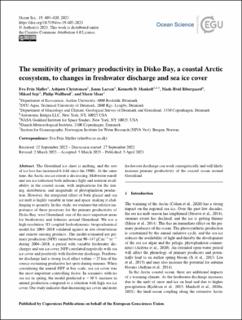The sensitivity of primary productivity in Disko Bay, a coastal Arctic ecosystem, to changes in freshwater discharge and sea ice cover
| dc.contributor.author | Møller, Eva Friis | |
| dc.contributor.author | Christensen, Asbjørn | |
| dc.contributor.author | Larsen, Janus | |
| dc.contributor.author | Mankoff, Kenneth D. | |
| dc.contributor.author | Hvid Ribergaard, Mads | |
| dc.contributor.author | Sejr, Mikael | |
| dc.contributor.author | Wallhead, Philip | |
| dc.contributor.author | Maar, Marie | |
| dc.date.accessioned | 2023-09-21T13:30:31Z | |
| dc.date.available | 2023-09-21T13:30:31Z | |
| dc.date.created | 2023-04-05T12:34:10Z | |
| dc.date.issued | 2023 | |
| dc.identifier.citation | Ocean Science. 2023, 19 (2), 403-420. | en_US |
| dc.identifier.issn | 1812-0784 | |
| dc.identifier.uri | https://hdl.handle.net/11250/3091122 | |
| dc.description.abstract | The Greenland ice sheet is melting, and the rate of ice loss has increased 6-fold since the 1980s. At the same time, the Arctic sea ice extent is decreasing. Meltwater runoff and sea ice reduction both influence light and nutrient availability in the coastal ocean, with implications for the timing, distribution, and magnitude of phytoplankton production. However, the integrated effect of both glacial and sea ice melt is highly variable in time and space, making it challenging to quantify. In this study, we evaluate the relative importance of these processes for the primary productivity of Disko Bay, west Greenland, one of the most important areas for biodiversity and fisheries around Greenland. We use a high-resolution 3D coupled hydrodynamic–biogeochemical model for 2004–2018 validated against in situ observations and remote sensing products. The model-estimated net primary production (NPP) varied between 90–147 gC m−2 yr−1 during 2004–2018, a period with variable freshwater discharges and sea ice cover. NPP correlated negatively with sea ice cover and positively with freshwater discharge. Freshwater discharge had a strong local effect within ∼ 25 km of the source-sustaining productive hot spots during summer. When considering the annual NPP at bay scale, sea ice cover was the most important controlling factor. In scenarios with no sea ice in spring, the model predicted a ∼ 30 % increase in annual production compared to a situation with high sea ice cover. Our study indicates that decreasing ice cover and more freshwater discharge can work synergistically and will likely increase primary productivity of the coastal ocean around Greenland. | en_US |
| dc.language.iso | eng | en_US |
| dc.publisher | Copernicus Publications | en_US |
| dc.rights | Navngivelse 4.0 Internasjonal | * |
| dc.rights.uri | http://creativecommons.org/licenses/by/4.0/deed.no | * |
| dc.title | The sensitivity of primary productivity in Disko Bay, a coastal Arctic ecosystem, to changes in freshwater discharge and sea ice cover | en_US |
| dc.type | Peer reviewed | en_US |
| dc.type | Journal article | en_US |
| dc.description.version | publishedVersion | en_US |
| dc.rights.holder | © 2023 The Authors | en_US |
| dc.source.pagenumber | 403-420 | en_US |
| dc.source.volume | 19 | en_US |
| dc.source.journal | Ocean Science | en_US |
| dc.source.issue | 2 | en_US |
| dc.identifier.doi | 10.5194/os-19-403-2023 | |
| dc.identifier.cristin | 2139521 | |
| dc.relation.project | EC/H2020/869300 | en_US |
| dc.relation.project | Sigma2: nn9490k | en_US |
| dc.relation.project | Sigma2: ns9630k | en_US |
| dc.relation.project | Sigma2: nn8103k | en_US |
| dc.relation.project | EC/H2020/2508970 | en_US |
| dc.relation.project | EC/H2020/727890 | en_US |
| cristin.ispublished | true | |
| cristin.fulltext | original | |
| cristin.qualitycode | 1 |
Tilhørende fil(er)
Denne innførselen finnes i følgende samling(er)
-
Publikasjoner fra Cristin - NIVA [2149]
-
Scientific publications [1172]

